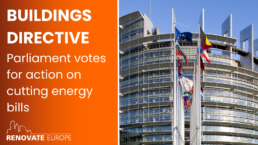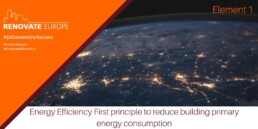At the Plenary session in Strasbourg on 14th March 2023, the European Parliament (EP) adopted its position on the Energy Performance of Buildings Directive (EPBD).
By adopting its EPBD position, the European Parliament has demonstrated its commitment to slashing energy imports, improving millions of homes, lowering this way the increased energy poverty rates.
With a stubbornly low renovate rate across the EU at only 1%, and a highly fragmented sector with over 95% SMEs, setting a clear regulatory framework with the EPBD could have a transformative effect in delivering the Renovation Wave, for the benefit of citizens and businesses, and for the planet.
The text introduces two new key elements:
- Minimum Energy Performance Standards (MEPS) for existing buildings, with non-residential buildings to reach D class by 2030, and residential buildings to reach D by 2033.
- Instruments to mobilise finance for renovation in order to support homeowners with renovations (such as Mortgage Portfolio Standards) in addition to significant EU funding already available for renovation.
The revision of the EPBD must set the whole of the building stock in the EU on a clearly planned trajectory towards deep renovation if the EU is to meet its 2050 carbon neutrality goals.
That is why from the Renovate Europe Campaign we have considered our duty to use this period of feedback, opened by the European Commission, prior to the adoption of the directive to provide our comments.
Long-term planning towards deep renovation will guarantee that the building sector contributes its fair share towards the green transition, but it will also provide a sustainable solution to the rising energy price crisis, through a reduction of citizens’ energy needs, alongside multiple other benefits. In a time of high EU-wide public investment being channelled to energy renovation through the Recovery Funds but also potentially through the EU’s 2021-2027 MFF budget, the EPBD cannot fall short on its renovation goals.
Renovate Europe therefore raises the following concerns and proposes the following recommendations:
- Apply Energy Efficiency First to the ZEB definition
- Set deep renovation as the guiding principle of MEPS
- Follow a long-term plan to strengthen the scope of MEPS to the full building stock through
- National Building Renovation Plans (NBRPs) and Building Renovation Passports (BRPs)
- Better align EPCs for the deep renovation of the full building stock

The revision of the EPBD is a necessary pre-condition to meet the Renovation Wave objectives and to achieve a highly energy efficient and decarbonised building stock by 2050. The stubbornly low energy renovation rate and depth across the EU clearly calls for the need to strengthen the provisions of the EPBD.
Renovate Europe is convinced that the following four regulatory measures must be introduced as they will be crucial in boosting renovation rates and depth in the EU:
1) Introduction of Minimum Energy Performance Standards (MEPS) for all renovations
2) Updating and improving the Energy Performance Certificate (EPC) Framework
3) Strengthening the requirements of the Long-Term Renovation Strategies (LTRS)
4) Setting an ambitious definition of an EU Deep Renovation Standard
In addition, Renovate Europe highlights the importance of the following four non-regulatory measures that will be essential to provide the needed enabling framework for a strengthened EPBD to be rolled out successfully:
1) Boosting Technical Assistance
2) Significantly Increased Financing
3) Supply Chain Capacity
4) Innovation

The Inception Impact Assessment for the revision of the EPBD proposes 3 different pathways.
- Renovate Europe strongly supports Option 3 ‘Amend the EPBD’ as this will be crucial to achieving the Renovation Wave objectives, with a clear focus on 1) Introduction of MEPS 2) Updating of the EPC framework and 3) Definition of deep renovation standard.
- Renovate Europe strongly believes that the non-regulatory measures outlined in Option 2 (particularly technical and financial support measures and supply chain capacity) also have a key enabling role to play.
Renovate Europe therefore suggests that both the regulatory measures proposed in Option 3 and the non-regulatory measures proposed in Option 2 must be synchronised in the most effective way in the context of the upcoming revision of the EPBD to boost the rate and depth of renovation across the EU.

Article 5 of the EED currently requires public authorities to renovate 3% of buildings owned and occupied by the central government. Unfortunately, the limited scope, weak enforcement and availability of alternative measures has resulted in Article 5 having very little impact on the ground. The upcoming revision of the EED is the opportunity to strengthen Article 5 in order to achieve our shared goal of increased rate and depth of renovation across Europe.
The Renovation Wave sets the objective of at least doubling the annual energy renovation rate by 2030. Indeed, reducing energy demand in the buildings sector is a prerequisite for achieving the EU’s agreed climate objectives. Energy renovation will also significantly contribute to the EU’s economic recovery, in addition to delivering multiple benefits to citizens (comfort, better air quality, improved health and productivity, lower energy bills, etc.). Unfortunately, the energy renovation rates and depths across the EU remains stubbornly low.
Article 5 of the EED has the potential to make a difference in boosting energy renovation in the EU, given the important role of public buildings. Since they are frequently visited by the public, public buildings contribute to raising awareness and must lead the way by example in achieving a high level of energy performance. The diversity of public buildings also means that they are a microcosm of what will need to happen in other building segments, and as such play a key role in preparing the market for wider uptake.
The upcoming review of the EED is the opportunity to strengthen Article 5 in the following ways:
- Wider scope beyond central government buildings
- Removal of alternative measures
- Depth of renovation ensured through MEPS
- Synergy with Long-term Renovation Strategies and National Recovery Plans
- Include worst-performing buildings to tackle energy poverty
- Provision of Technical Assistance, especially for regional and local authorities
- Prioritization of loans and other financial instruments
- Support Innovation and upskilling of workforce
- Stronger oversight and better data collection
- Greater emphasis on multiple benefits
A stronger Article 5 in the upcoming review of the EED will be crucial in boosting the renovation rate and depth in the EU and ensuring we can meet the Renovation Wave goals.
- Application of Energy Efficiency First principles to programme and projects ;
- Scale up good practice experiences;
- Buildings’ segments-driven obligations towards ambitious energy performance requirements;
- Consider ownership structures and consumer segmentation;
- Adoption of area-based approach;
- Creation or reinforcement and coordination of renovation-focussed agencies in Member State;
- Use trigger points in the life of a building to motivate deep energy renovations;
- Build more capacity in the buildings sector;
- Use individual building renovation passports;
- Leverage all available financing tools and instruments.
Learn more about Renovate Europe’s Call in April 2020 for the creation of a “Renovation Fund for All Europeans”, supported by 125 signatories

Creating a Renovation Management Facility as part of the Renovation Wave
The Renovation Wave Strategic Communication and Action Plan will be published on 15th October.
All eyes are on the EU to help the Member States exit this unprecedented economic downturn. The moment is now to set up a Renovation Management Facility as part of the Renovation Wave to deliver on the European Green Deal’s promise to “at least double” the annual energy renovation rate and make its flagship initiative, the Renovation Wave, a success.
Energy renovation stands at the perfect intersection between the EU’s growth objectives and green priorities. Member States have a strong argument for prioritising energy renovation in their National Recovery & Resilience Plans to be submitted to the Commission by 15th October 2020. But Member States will need the technical support, financial knowledge and management capacity to assist them in drawing together the different EU financing options and implement the needed reforms to roll out National Renovation Programmes.
The Renovation Wave Strategic Communication and its associated Action Plan to be published in October offer the perfect opportunity to establish a Renovation Management Facility that could do just that – help to match the EU funds with bankable, scalable energy renovation programmes, supported by a competent overall management facility to guarantee implementation and results.
- Read here a document about the Renovation Management Facility briefly explaining who would manage the Renovation Management Facility, what its main function would be, how it would differ from other EU technical supports already available and how it would ensure that the EU reaches its 2050 climate goals.











